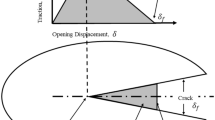Abstract
The cohesive zone parameters (separation energy and cohesive strength) and the crack tip triaxialities are compared between a compact tension (CT) and a double edge notched tension (DENT) specimen with smooth side-surfaces. The material is a pressure vessel steel 20MnMoNi55. The cohesive zone parameters are determined by fitting the simulated crack extensions near the midsection to the experimental data. The purpose of the study is to understand the relationship between the cohesive zone parameters and the crack tip stress triaxiality. The results show that for the same cohesive zone parameters the crack tip triaxiality near the midsection is lower in DENT specimens than in CT specimens. When the separation energy is set constant for CT and DENT specimens, the cohesive strength for the DENT specimens should be significantly lower than that for the CT specimens in order to make the simulated crack extensions near the midsection fit to the experimental data. Near the midsection, the cohesive strength and crack tip triaxiality influence each other: the specimen with a higher stress triaxiality has a higher cohesive strength; an increase of cohesive strength results in an increase of the crack tip triaxiality.
Similar content being viewed by others
References
G.I. Barenblatt (1962) ArticleTitleThe mathematical theory of equilibrium cracks in brittle fracture Advances of Applied Mechanics 7 55–129 Occurrence Handle10.1016/S0065-2156(08)70121-2 Occurrence Handle149728
W. Brocks W. Schmitt (1995) ArticleTitleThe second parameter in J--R curves: constraint or triaxiality ASTM STP 1244 209–231
C.R. Chen O. Kolednik I. Scheider T. Siegmund A. Tatschl F.D. Fischer (2003) ArticleTitleOn the determination of the cohesive zone parameters for the modeling of micro-ductile crack growth in thick specimens. International Journal of Fracture 120 517–536
Chen, C.R., Kolednik, O., Heerens, J. and Fischer, F.D. (2005). Three-dimensional modeling of ductile crack growth: cohesive zone parameters and crack tip triaxiality Engineering Fracture Mechanics. (In press).
A. Cornec I. Scheider K.H. Schwalbe (2003) ArticleTitleOn the practical application of the cohesive model. Engineering Fracture Mechanics 70 1963–1987
D.C. Dugdale (1960) ArticleTitleYielding of steel sheets containing slits. Journal Mechanics Physics Solids 8 100–104 Occurrence Handle1960JMPSo...8..100D
A.L. Gurson (1977) ArticleTitleContinuum theory of ductile rupture by void nucleation and growth-I. Yield criteria and flow rules for porous ductile media. ASME Journal of Engineering Materials Technology 99 2–15
J.W. Hutchinson A.G. Evans (2000) ArticleTitleMechanics of materials: top-down approaches to fracture Acta Materialia 47 125–135
A. Needleman (1987) ArticleTitleA continuum model for void nucleation by inclusion debonding. Journal of Applied Mechanics 54 525–531 Occurrence Handle0626.73010 Occurrence Handle10.1115/1.3173064
A. Needleman (1990) ArticleTitleAn analysis of decohesion along an imperfect interface International Journal of Fracture 42 21–40
Y.A. Roy R.H. Dodds (2001) ArticleTitleSimulation of ductile crack growth in thin aluminum panels using 3-D surface cohesive elements International Journal of Fracture 110 21–45
S. Roychowdhury Y.A. Roy R.H. Dodds (2002) ArticleTitleDuctile tearing in thin aluminum panels: experiments and analyses using large-displacement, 3-D surface cohesive elements Engineering Fracture Mechanics 69 983–1002
T. Siegmund W. Brocks (1999) ArticleTitlePrediction of the work of separation and implication to modeling International Journal of Fracture 99 116
T. Siegmund W. Brocks (2000a) ArticleTitleThe role of cohesive strength and separation energy for modeling of ductile fracture ASTM STP 1360 139–151
T. Siegmund W. Brocks (2000b) ArticleTitleA numerical study on the correlation between the work of separation and the dissipation rate in ductile fracture Engineering Fracture Mechanics 67 139–154
V. Tvergaard J.W. Hutchinson (1992) ArticleTitleThe relation between crack growth resistance and fracture process parameters in elastic–plastic solids Journal of Mechanics and Physics Solids 40 1377–1397 Occurrence Handle0775.73218 Occurrence Handle1992JMPSo..40.1377T
V. Tvergaard J.W. Hutchinson (1996) ArticleTitleEffect of strain-dependent cohesive zone model on predictions of crack growth resistance International Journal of Solids and Structures 33 3297–3308 Occurrence Handle0905.73056
V. Tvergaard (2004) ArticleTitlePredictions of mixed mode interface crack growth using a cohesive zone model for ductile fracture International Journal of Solids and Structures 52 925–940 Occurrence Handle1074.74055
L.L. Xia S.F. Shih (1995a) ArticleTitleDuctile crack growth-I. A numerical study using computational cells with microstructurally-based length scales. Journal and Mechanics and Physics Solids 43 233–259 Occurrence Handle0879.73047 Occurrence Handle1995JMPSo..43..233X
L. Xia S.F. Shih (1995b) ArticleTitleDuctile crack growth-II. Void nucleation and geometry effects on macroscopic fracture behavior. Journal and Mechanics and Physics Solids 43 1953–1981 Occurrence Handle0919.73257 Occurrence Handle1995JMPSo..43.1953X
H. Yuan G.Y. Lin A. Cornec (1996) ArticleTitleVerification of a cohesive zone model for ductile fracture ASME Journal of Engineering Materials Technology 118 192–200
Author information
Authors and Affiliations
Corresponding author
Rights and permissions
About this article
Cite this article
Chen, C.R., Kolednik, O. Comparison of cohesive zone parameters and crack tip stress states between two different specimen types. Int J Fract 132, 135–152 (2005). https://doi.org/10.1007/s10704-005-0626-2
Received:
Accepted:
Issue Date:
DOI: https://doi.org/10.1007/s10704-005-0626-2




